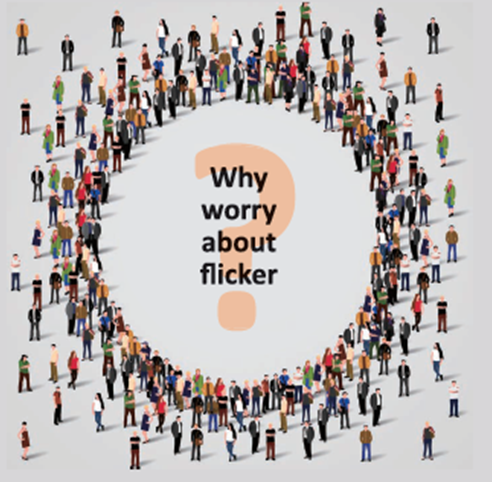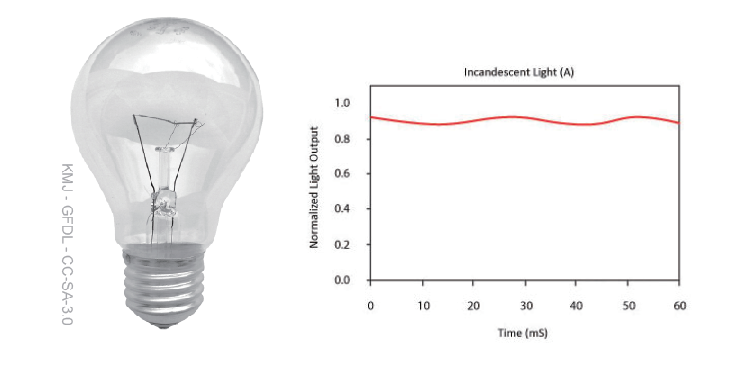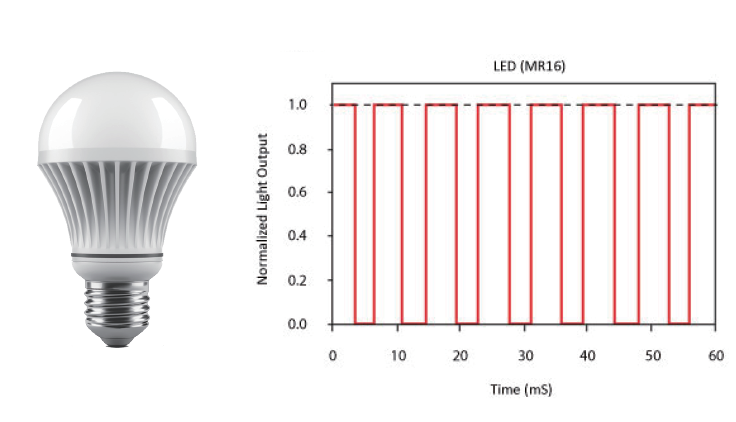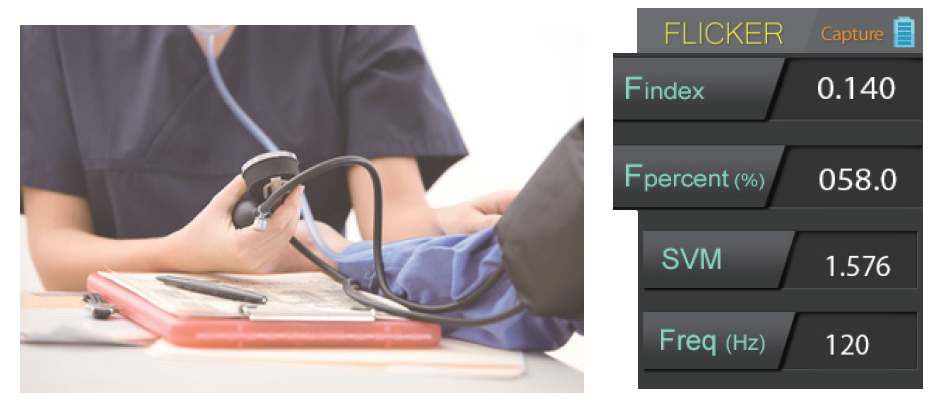LIGHT WAVE MEASURING
LED LIGHT WAVE MEASUREMENT, WAVE FAST FOURIER TRANSFORM MEASUREMENT, LIGHT SOURCE WAVE INTENSITY MEASUREMENT
Suspicions about the adverse effects from flicker (visible and non-visible) have been around ever since fluorescent lighting was incorporated into the work place (around the 1950s). The effects of flicker have been well studied and include, but are not limited to, headaches, mi¬graines, eye strain, fatigue, and even epileptic seizures. Even if flicker cannot be visually seen, flickering light can still enter through your eyes, reaching our retinas, traveling the neural circuitry to your central nervous system (brain), where they pound your senses, potentially wreaking havoc. In short, flicker can present a silent, most times invisible and insidious problem.
Not everyone is susceptible to light flicker, and it’s hard to quantify what percentage of the pop-ulation is actually light flicker sensitive. At best, we found a source that estimates 1 in 4000 (1) individuals suffer from photosensitive epi¬leptic seizures (light sensitive seizures). It is also hard to quantify exactly what levels of flicker exceed thresholds for safety and health. Our visual senses and central nervous systems are complex and vary from person to person. Differ¬ences in age, visual acuity and bodily chemistry vary greatly and exacerbate the problem even more. Ambient lighting from multiple sources also adds to the complexity of Flicker. Do multi-light environments reduce flicker, increase flicker or both? What level of flicker severity can be considered safe for such a diverse, fluid and multi-faceted environment? In short, it is an extremely difficult problem to get your arms around. This article is using MF250N Flicker Meter processing an actual Light Wave Measurement and according to IEEE recommended standard to estimate the risk of Flicker.
1 in 4000 Suffer from Photosensitive Epileptic Seizures
If only 1 in 4000 individuals suffer from photosensitive epileptic seizures, which is a mere .025 percent of the population, why worry? First, are you willing to risk even a remote possibility of something as catastrophic as an epileptic seizure occurring on your premises, especially if it can be almost completely avoided. Second, aside from seizures, there are lots of gray areas of flicker induced health problems that are not clearly defined, although well documented and stud¬ied (headaches, migraines, autistic behavioral response, work fatigue). Third, it’s not only the occasional headaches or migraines. Other studies claim that produc¬tivity increases 8%(2) in flicker free environments with general mood ratings (well being, happi¬ness levels) also increasing 33%. This should be a concern for companies for every day of the week and every working hour of the day.
Incandescent Light Wave
Let’s say a word about the traditional incandescent lights, which certainly flicker, but for the most part are negligible. These lights have a filament which glows when it is heated with the flow of electricity. They usually will not have flicker issues because the heat and light from the filament lingers, like a simmering red hot iron, long past each peak and trough of a flicker cycle. The AC current still fluctuates through an Incandescent bulb, but the flicker is washed out by the long continuous burn of the filament. Below is the light wave for an incandescent light. Notice that there is still some flicker, but hardly noticeable because of the shallow difference between high and low intensities.
Fluorescent Light Wave
With fluorescent and LED bulbs, light is produced differently. There is no filament to burn – instead, light is produced by the phenomenon of jumping electrons (see UPRtek Survival Handbook on explanation) that turn off and on light almost instantaneously (fluorescent in milliseconds, LED in microseconds). Below is a light wave for a fluorescent light.
LED Light Wave
Below is a light wave for an LED light. Notice the sharp corners that drop off between high and low intensities, indicative of sudden on/off characteristic of LEDs (faster than Fluorescent). (Note that LEDs can be fitted with “drivers”, covered later, that can quite drastically change the shape of the wave).
Light Wave Measurement Cases
Now, here are some practical cases of several light sources in our life which is measured by MF250N Flicker Meter, let’s see if the hidden Flicker is already a harm in your life. When you first examine a light with a flicker meter, one of the first things you can do is get a quick visual assessment by looking at the light wave. Following A light wave is more smooth than others, and it shows that A light is having lower changes to have Flicker than others.
Estimate the Risk of Flicker
Besides the light wave measurement, according to the recommend by IEEE Std 1789- 2015, let’s estimate the risk of flicker. Below is a measurement result of a light:
1) Calculate Frequency * .08 (120 * .08 = 9.6)
2) Compare Percent Flicker (58.0) against the calculated number (9.6)
If your Percent Flicker is larger than the calculated number in #1 (and it is for us 58.0 > 9.6), you have a Flicker problem with your lights and you need to take action (replace or buy new).
But what if you just bought and installed 20 LED light bulbs and your calculations showed as below.
14 > 120 * .08 = 9.6
Our Percent Flicker (14) is over the 9.6 limit, but by only a mere than 5 percentage points, much bet-ter than the 50 point spread in the previous example. Do I change my bulbs? No one at this time can answer that question with absolute clarity – once you get over the limit you are entering gray areas. It’s kind of like High Blood Pressure – the cutoff for high blood pressure is 140/90; but if your BP is 141/91, should you start taking medication? What if your BP is 139/89?
For most modern lighting environments, you probably will not see any noticeable flickering. However, just because you can’t see flicker, doesn’t mean that there isn’t any flicker. UPRtek handheld spectrometer will help you see the invisible Flicker and guard your health. If you wish to learn more about Flicker, you are welcome to have further information from Flicker Handbook on our website.
Reference
:(1) Photic- and pattern-induced seizures: a review for the Epilepsy Foundation of America Working Group.
https://www.ncbi.nlm.nih.gov/pubmed/16146439
(2) Luma Stream – LED Lighting and Workplace Productivity
http://www.lumastream.com/sites/default/files/blog-thumbnails/lumastream_led_lighting_and_workplace_productivity-2.pdf
MK350N Premium is a Spectrum Analyzer, LED Meter and Flicker Meter for LED manufacture. Embedded with spectral technology and optimize the LUX measuring range. Overall, the measuring MK350S Premium is a Handheld Spectrometer with Muli-Functions in itself. It's not only a Spectrometer, but also can be a Quantum PAR Meter, Blue light Detector and Oscilloscope. The UPRtek Compact MK350D is the pocket-Sized spectrometer in the world and released in 2014. It is only 70g and easy to carry. Measurement light units are more than 27, such as CCT, LUX, CRI, MF250N Handheld Spectral Flicker Meter-The 1st Handheld Flicker Meter with spectral technology. It is also a FFT Spectrum Analyzer, Light wave Meter and Frequency Analyzer. It provides 3 major CV600 - All purpose Professional Cinematic and Photographic Light meter. It is not only a Light meter, but also a Color meter, Cine meter and Exposure meter a quicker, more efficient measurements for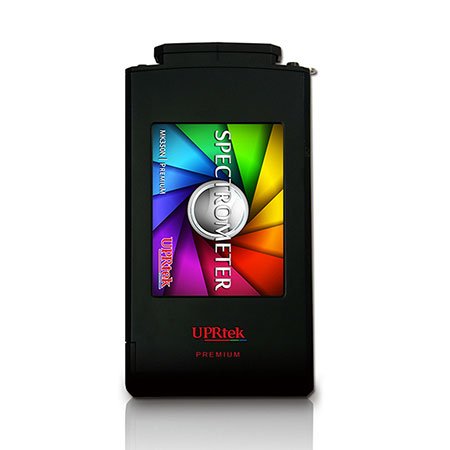
Stand alone Spectral Light meter-Handheld Spectrometer
MK350N Premium

Visual Merchandising, LED Lighting Solutions-Handheld Spectrometer
MK350S Premium
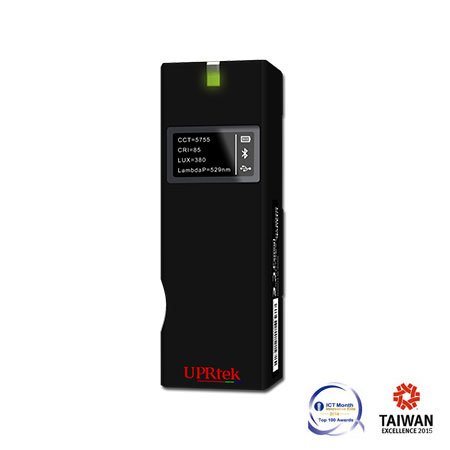
Compact Spectrometer
MK350D

Handheld LED Flicker Meter
MF250N

SPECTRAL COLOR METER
CV600
Introduction on LED lighting flicker, potential health concerns and anti-flicker solution MK350 Series Spectrometer basic optical know-how and case study
MF250N Flicker Meter - Flicker Handbook (English Version)

MK350S Premium Spectrometer - MK350 Series Survival Handbook (English Version)


